Search
To search for an exact match, type the word or phrase you want in quotation marks.
A*DESK has been offering since 2002 contents about criticism and contemporary art. A*DESK has become consolidated thanks to all those who have believed in the project, all those who have followed us, debating, participating and collaborating. Many people have collaborated with A*DESK, and continue to do so. Their efforts, knowledge and belief in the project are what make it grow internationally. At A*DESK we have also generated work for over one hundred professionals in culture, from small collaborations with reviews and classes, to more prolonged and intense collaborations.
At A*DESK we believe in the need for free and universal access to culture and knowledge. We want to carry on being independent, remaining open to more ideas and opinions. If you believe in A*DESK, we need your backing to be able to continue. You can now participate in the project by supporting it. You can choose how much you want to contribute to the project.
You can decide how much you want to bring to the project.
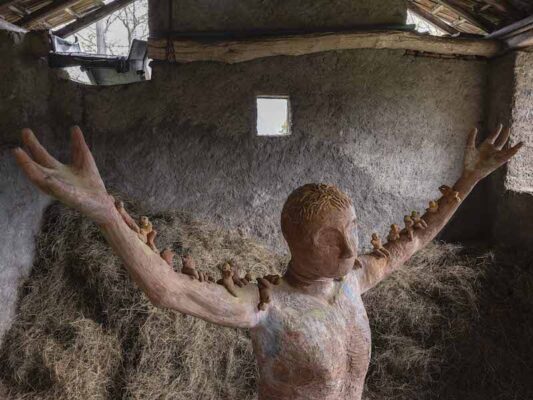
Producing culture in synchrony with geological time lies at the core of Thinking Like a Mountain, the final chapter of Il Biennale della Orobie under the artistic direction of Lorenzo Giusti. A two-year programme that rejects the conventional exhibition logic to take root in the pre-Alpine territory of Bergamo, Lombardy. The biennium activates what Donna Haraway would call staying with the trouble: a sustained commitment to the ecological “problem,” to a living ecosystem, and to a being-with-and-in the territory that refuses standard exhibition timelines. The mountain is not a backdrop—it is the interlocutor.
Extractive Landscapes and Scars of the Anthropocene
The memory of extraction resurfaces in multiple layers. In an abandoned mine in Dossena, in the Brembilla Valley, Julius von Bismarck transforms the rocky walls of the mine into a two-dimensional landscape. Landscape Painting (Mine) interrogates the legacies of extractivism in the age of the Anthropocene. The work does not represent—it converts the mining wound into a reflective space on the violence inscribed in the territory.
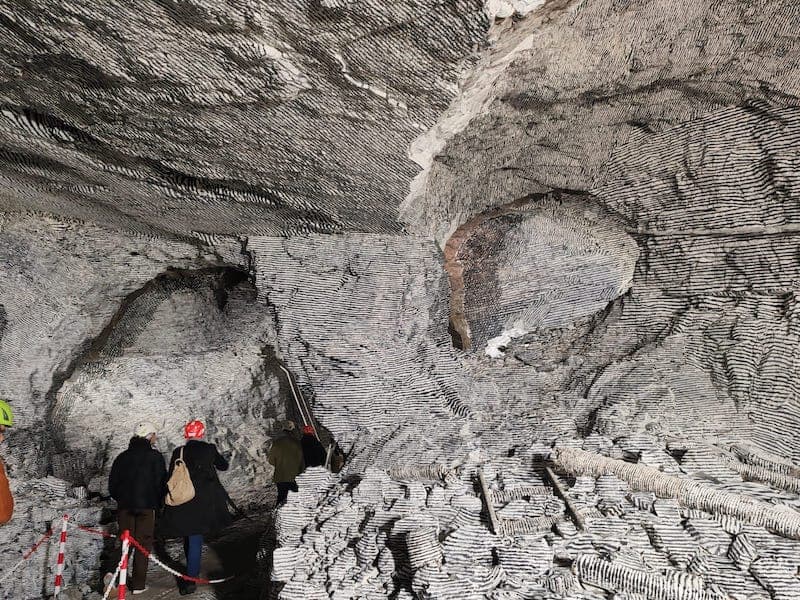
Julius von Bismarck, Landscape Painting (Mine), 2025, Dossena Mines, Bergamo. Photo: María Muñoz Martínez
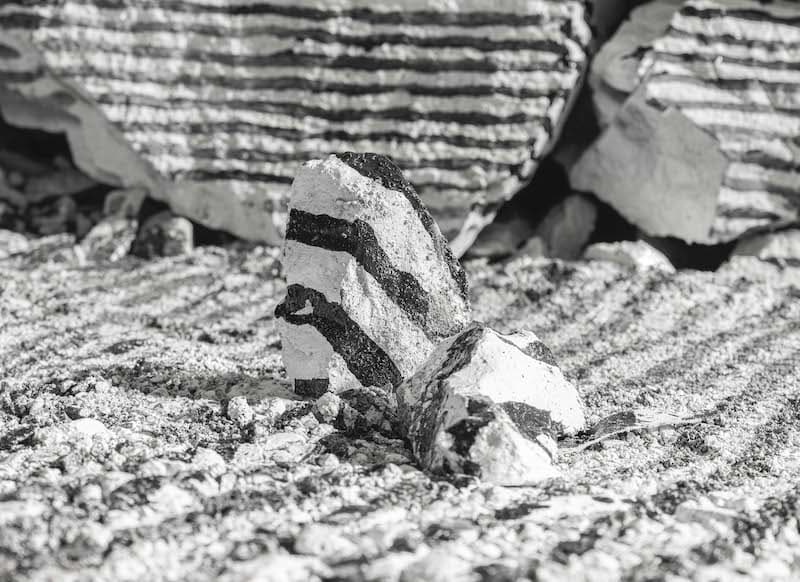
Julius von Bismarck, Landscape Painting (Mine), detail, 2025, Dossena Mines, Bergamo
In the industrial area of Dalmine, Abraham Cruzvillegas installs a monumental sculpture made from local waste materials, reshaped into forms akin to contemporary fossils. His gesture performs a kind of reverse archaeology: instead of unearthing the remains of the past, it compresses the residues of the present into future geological strata. These projects chart a form of necropolitics of the territory—the traces of power that determine which lives (human and non-human) are worth living, and which spaces can be sacrificed.
Fragile Architecture: The Bivouac as Curatorial Gesture
The most radical project, however, is not housed within a gallery but stands 2,000 metres above sea level. It is the new Bivacco Frattini, conceived by studio EX. in collaboration with the Italian Alpine Club. This lightweight, reversible textile structure rejects monumentalism. It hosts no exhibitions; instead, it serves as GAMeC’s outpost in the alpine mountains—a shelter always open, coexisting with the landscape without dominating it.
The bivouac embodies a politics of fragility. Its red, tent-like covering is not a symbol of conquest but of shared vulnerability. Equipped with environmental sensors, the shelter also functions as an ecological monitoring station, expanding the notion of “curating” into the “care” of the alpine ecosystem. Rather than extracting resources or meanings, its gesture is one of listening—of a multispecies ethnography that registers the pulse of a living territory.
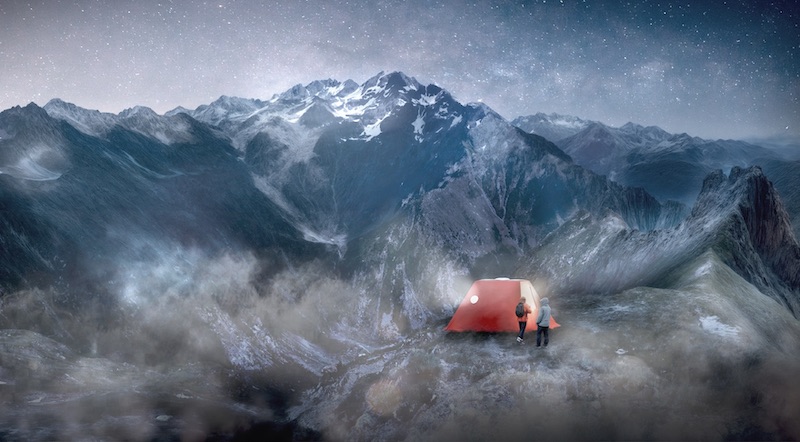
EX., New Bivacco Frattini
More-Than-Human Communities
The biennium extends its research toward forms of community that transcend the human. In the Valle della Biodiversità di Astino, Asunción Molinos Gordo conducts a workshop that connects art and agriculture through seed banks. Her project reclaims vegetal kinship as a practice of resistance, transforming orphan crops into narratives of care, memory, and community—establishing alliances across species.
Meanwhile, the collective Atelier dell’Errore, which works with neurodivergent youth, presents TEN at GAMeC —a retrospective of drawings that seem to emerge from a fantastical biology, where electric deer and transparent wolves speak the language of the forest. Far from any therapeutic or sentimental framing, the project affirms an alternative ecological intelligence that challenges the neurotypical patterns of the art world.
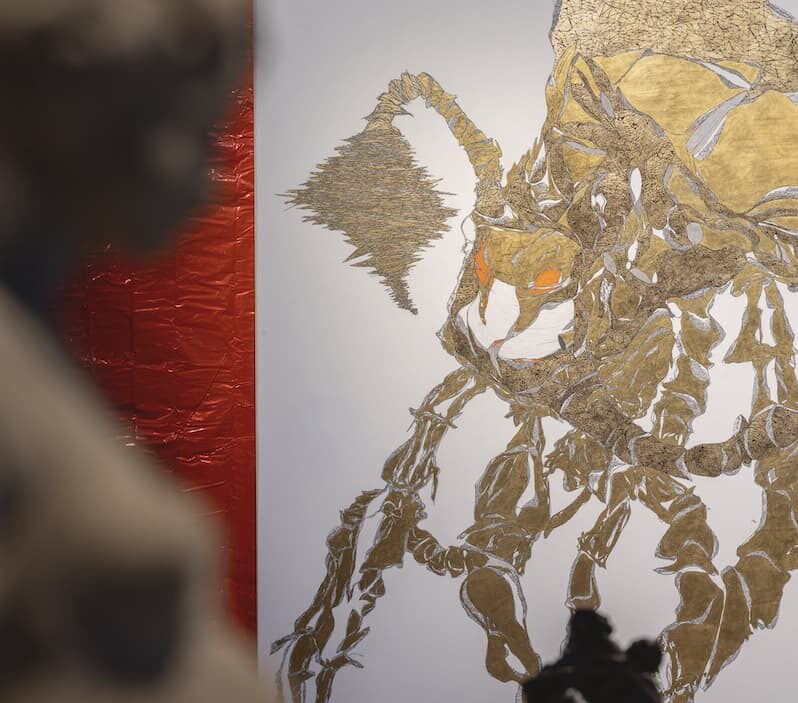
Atelier dell’Errore, exhibition view, TEN, GAMeC, 2025
Art in Deep Time: Metabolisms and Materialities
The exhibition also unfolds what might be called aesthetics of metabolism—works that share rhythms with the living and the geological. In Sottochiesa, a depopulated mountain village, Gaia Fugazza presents Mother of Millions, a porous clay sculpture replicating the Kalanchoe delagoensis plant, capable of asexual self-reproduction. The work functions as an organic metaphor of resilience, but also as a critique of policies that abandon “unproductive” territories. Here, artistic practice aligns with vegetal cycles, proposing a model of creation that does not impose, but germinates.
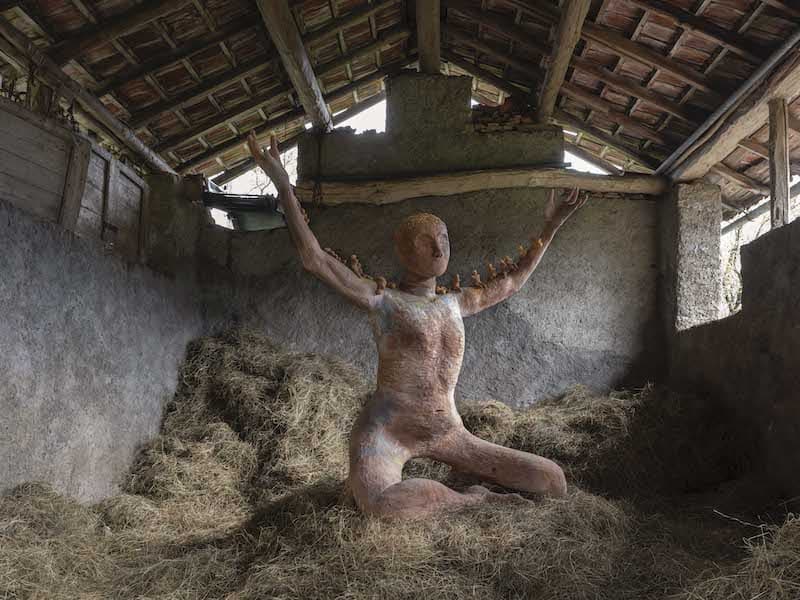
Gaia Fugazza, Mother of Millions, 2025, installation, Stalla Gherba, Sottochiesa, Bergamo
In Almenno San Bartolomeo, Agnese Galiotto dematerializes the landscape with her public mural The Mountain Does Not Exist. A triangle extending the silhouette of Monte Albenza, where human hands, migratory birds, and twin flowers merge in a single gesture of care—proposing a relational landscape where everything is interconnected.
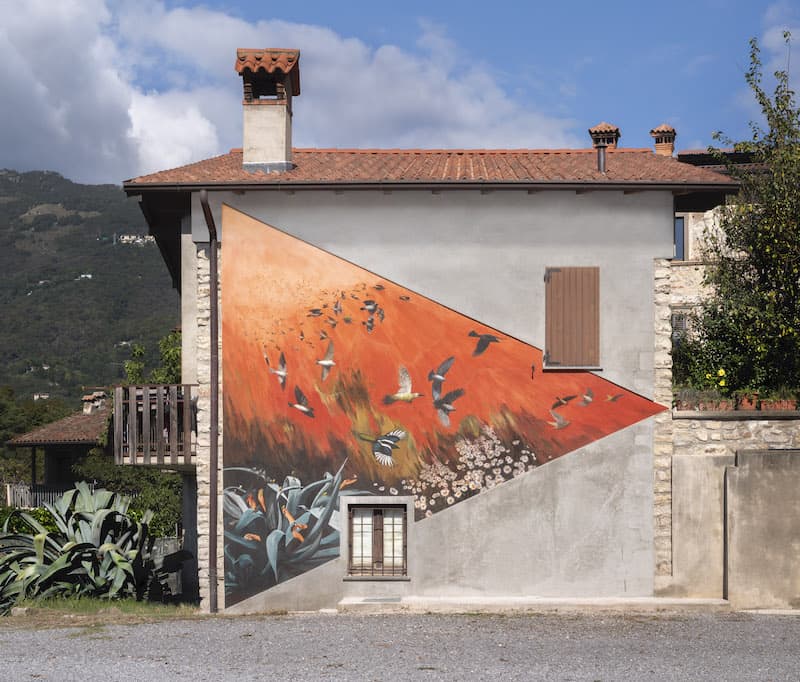
Agnese Galiotto, La montagna non esiste, 2025, fresco, Almenno San Bartolomeo, Bergamo
In a deconsecrated Romanesque church in Gerosa, Bianca Bondi installs Graces of Gerosa, a sculptural ensemble incorporating crystals, salt, and oxidizing materials that react to ambient humidity. The work breathes with the space, updating a notion of sculpture as a metabolic entity—constantly in dialogue with its surroundings and persisting in a state of continuous transformation. These works operate in deep time, resisting immediacy to embrace slower, almost geological cycles, where creation is measured in processes rather than finished products.
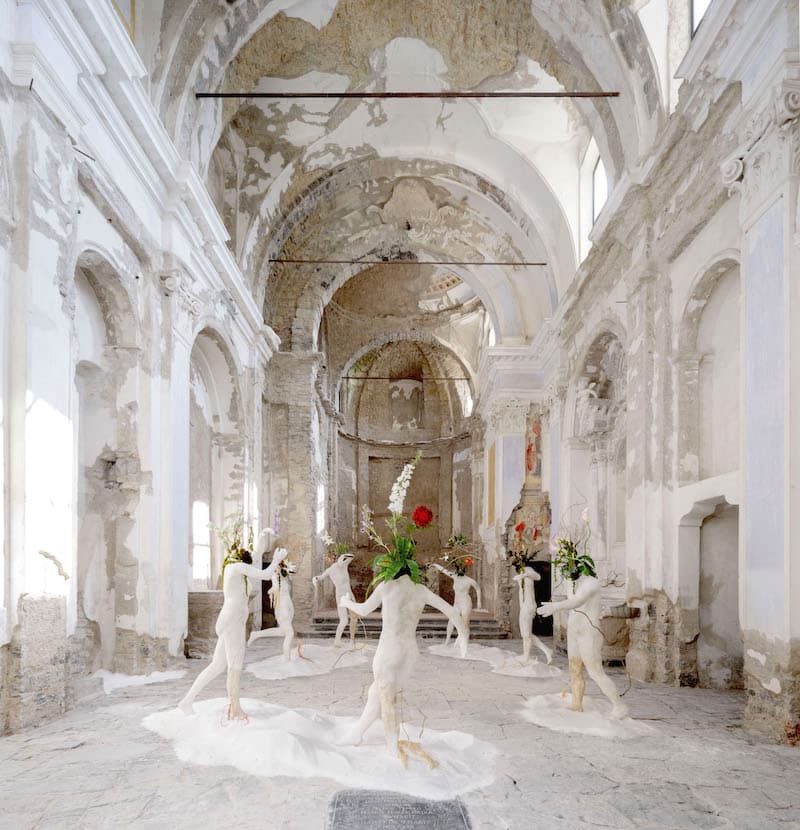
Bianca Bondi, Graces for Gerosa, 2025, installation view, Church of Santa Maria in Montanis, Gerosa (Val Brembilla), Bergamo
Long-Term Projection and Radical Sustainability
The Orobie biennial model rests on three pillars where sustainability is not a theme, but a method: first, practical ecology (site-specific works using local waste materials and reflecting on biodiversity); second, social engagement (the direct participation of local inhabitants in creative processes); and third, cultural perspective (sculpting with what the territory itself offers).
Unlearning the Institution
Thinking Like a Mountain, the final cycle of this two-year programme, concludes not with closure but with the crystallization of methodologies. Il Biennale della Orobie does not merely thematize ecology—it reconfigures the artistic institution through deceleration, reciprocity, and commitment to the local. In contrast to the conventional global biennial model, Orobie proposes a form of critical rootedness. Here, the global takes root in the local; international artists do not impose visions but establish prolonged dialogues with valley and village communities, generating works that scale according to context.
A cultural practice measured not by immediate impact, but by the traces it leaves in the landscape and collective imagination. To think like a mountain, ultimately, is to accept that the most necessary art is that which erodes slowly, like rock, to become part of the common ground.
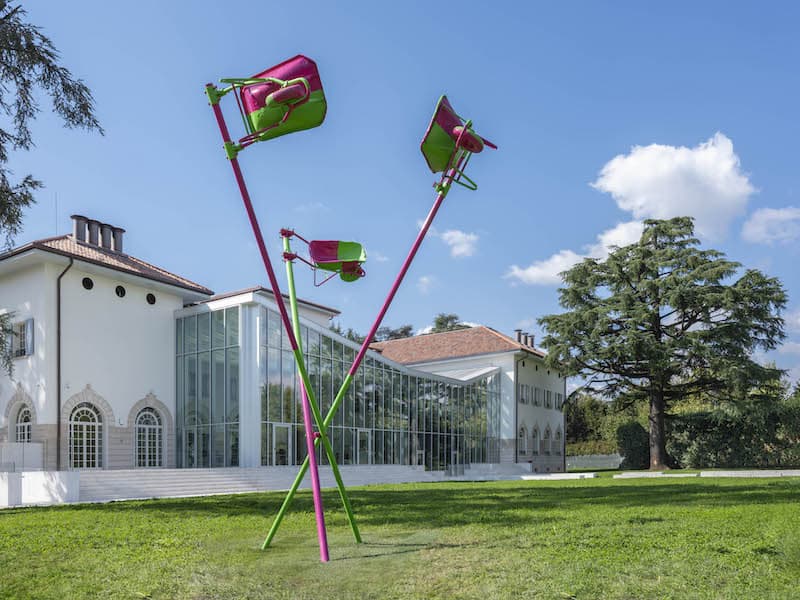
Abraham Cruzvillegas, An unstable and precarious self-portrait munching some traditional Fritos, sipping a couple of caballitos of Casa Dragones, after a busy journey with some dear friends, listening at the same time to the “Clair de lune,” performed by Menahem Pressler, and “Folie à Deux,” by Stefani Joanne Angelina Germanotta, 2025, installation view, Fondazione Dalmine, Bergamo
All images (except where indicated) by Nicola Gnesi Studio © GAMeC
[Cover photo: Gaia Fugazza, Mother of Millions, 2025, installation detail, Stalla Gherba, Sottochiesa, Bergamo]
Il Biennale della Orobie: the Bivacco by Studio EX and the projects by von Bismarck, Galiotto, and Francesco Pedrini (the result of a previous iteration) remain on view. The rest can be visited until January 18, 2026.
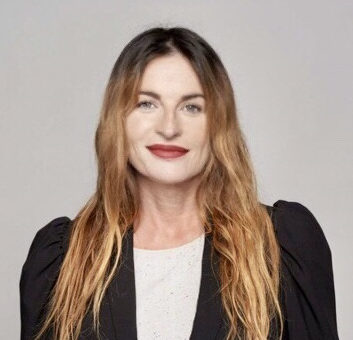
María Muñoz-Martínez is a cultural worker and educator trained in Art History and Telecommunications Engineering, this hybridity is part of her nature. She has taught “Art History of the first half of the 20th century” at ESDI and currently teaches the subject “Art in the global context” in the Master of Cultural Management IL3 at the University of Barcelona. In addition, while living between Berlin and Barcelona, she is a regular contributor to different media, writing about art and culture and emphasising the confluence between art, society/politics and technology. She is passionate about the moving image, electronically generated music and digital media.
Portrait: Sebastian Busse
"A desk is a dangerous place from which to watch the world" (John Le Carré)